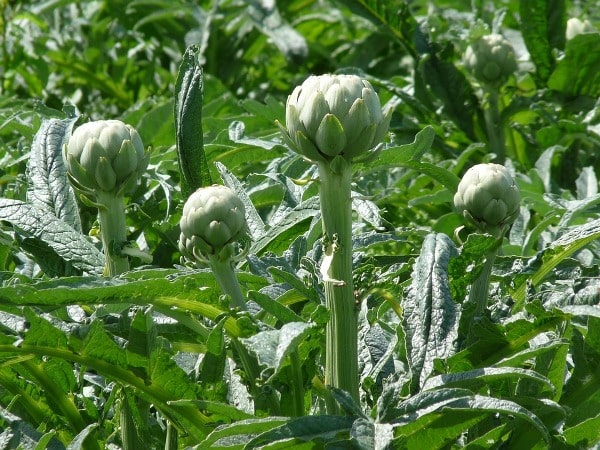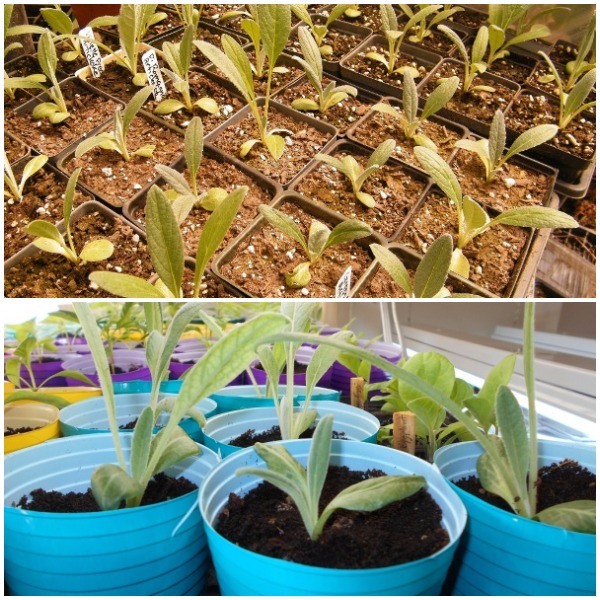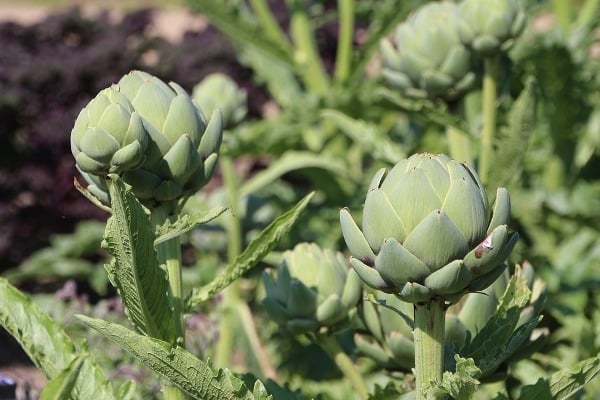Growing Artichokes In Containers:
The following information is about Growing Artichokes In Containers, and Pots.
Growing Artichokes in Containers:
Introduction: The artichoke is a wild plant cultivated for its thistle, which is consumed as food. The artichoke is an edible part of the flower bud which is harvested before it blooms into a flower. These are perennial plants, thrive in mild winter regions and medium summer (the summer that doesn’t have too much dry weather).
The plant produces flower bud clusters, a cluster has many budding small flowers with many bracts with an edible base. This vegetable plant grows up to 4 to 6 feet tall, and 3 to 4-inch width.

This vegetable grows to 1.4–2 m (4.6–6.6 ft) tall, with arched branches, and has deeply lobed, silvery, Glaucous-green leaves about20-30 inches long. The buds of the plants are consumable, these buds produce flowers of diameter 3 to 6 inches with many triangular scales and the florets in a deep purple color. The artichoke has a fleshy lower portion of each bract and the base of the bud works as a heart. And the center of the bud you find a mass of immature florets called a choke. These chokes are edible when the bud is young and are inedible the bud grows larger and produces flowers.
Once the buds start to bloom, the taste chokes go hard, bitter, and becomes inedible. And there is another variety of artichokes called cardoon, it is also a perennial plant that grows well in mild winter and mild summer regions.
Artichokes are the richest source of Vitamin C and are rich in dietary fiber that keeps the digestive system, healthy. The leaves of the artichoke plants have a rare element called Cynarin which plays a key in the healthy functioning of our liver.
And this wild-growing flowering plant, grows well in containers, with a good amount of space for its complete root system.
Varieties of Artichokes for Growing Artichokes in Containers:
There are primarily two types of Artichokes: ‘Globe’ artichokes these varieties will be long and round shape, and another variety is elongated, and tapered artichokes like ‘Violetta’. All varieties require similar climatic conditions, potting soil, and cultural requirements. All most all varieties of artichokes grow well in mild summer and mild winters. Some artichokes are not grown well in USDA zones 7 overwinter in Zones 7 and above. To protect artichoke plants from freezing winters, they should have mulched deeply with straw or dead leaves. For growing artichokes in colder zones, choose artichoke varieties that grow in a single season.
Globe Artichokes for Growing Artichokes in Containers:
Globe artichokes are the most common and familiar variety, these are fat round-shaped artichokes. These are what you commonly available in the supermarkets. Globe artichokes are large and are about 10-13 cm in size.
- Green Globe: these artichokes are open-pollinated varieties, the harvesting period is 90-100 days. These artichokes are the most popular and original globe variety artichokes, these are plants that produce 3 to 5 artichokes of size about 8 to 13cm. These buds have creamy thick, delicious hearts. This artichokes plants grow well in zones 7 and above. These plants produce artichokes for 5 years
- Imperial Star: These artichokes are open-pollinated, the harvesting period is 85 days. These plants are for annual production and it is propagated from seeds. Grows in USDA zones from 1 to 6. Each flower cluster produces 6 to 9 buds about 8 to 10cm in size. These plants are grown 1 to 2 meters tall and wide.
- Tempo is a hybrid variety artichoke plant, harvesting period is 100 days. It grows well in USDA zone 1 to 6. Each cluster produces main 3 to 4 buds of size 10-13 cm in diameter and 10 to 15 secondary buds. And the bracts have a purple tinge.
Elongated Artichokes variety for Growing Artichokes in Containers:
Violetto is an open-pollinated artichoke plant, harvesting period is 85 to 100 days. It is an Italian variety that produce elongated artichoke of width 8 cm and 13 cm long, with violet on the bracts. These plants produce 6-8 main buds, along with many secondary chokes. The dozens of ‘baby’ chokes produced later in the season.
Suitable Containers for Growing Artichokes in Containers:

- For growing artichokes in containers, you need a large container. A large container can accommodate enough space for the plants to grow.
- The ideal size of the container for growing artichokes should 24-inch-deep and 38 inches wide, this size can give enough space for its root system to expand. An artichoke plant can grow about 30 to 50 artichokes in a growing season.
- Grown one plant in a container, even you use a large container, grow only one plant in a container.
- The container you select should be able to hold 2 to 3 gallons of soil. Make sure to have a container to hold at least 2 cubic feet of soil for better plant growth.
- The container should have a good draining system, young plants have more chances of root rot in case of improper draining. The container should have 2 to 3 draining holes.
Potting Soil for Growing Artichokes in Containers:
- Artichokes thrive well in sandy, nitrogen-rich, and well-drained soil. The soil should give root easy access to the nutrients. And should retain moisture and nutrients, and capable of draining excess water without any waterlogging.
- If you are using gardening soil, use rich organic and fertile soil. The pH levels of the soil are range from 6 to 6.8. And mix the soil with mixed natural compost and aged manure for a few days before planting the seeds. Enriching the soil with compost will increase the nutrient levels in the soil. Enriching the soil with yucca extract will make to retain moisture for long periods.
- You can also mix all-purpose mild granular fertilizer into the soil for a few days before filling it into the desired container.
- These plants grow well under constant moisture levels, check the water levels in the soil at regular intervals.
- Instead of gardening soil, go for good quality commercial potting soil, rich in organic matter and vermiculated.
Propagating Methods for Growing Artichokes in Containers:
- Artichokes can be grown from seeds and from offsets. The plant grows well from both methods.
- If planning to grow artichokes from seeds, you have to get some good quality seeds from a reputed vendor. And soak the seeds in warm water overnight, this helps to fasten the germination process. Sow the seeds two weeks before the last spring frost.
- For growing artichokes in containers, growing from root divisions will be a good option as it grows easily. Or it can also grow from the offset, offset soon grown to the mother plant.
- The offset for growing artichokes should be not less than 10 inches, too small offsets may not survive. And too tall are difficult to manage.
- To get offset, dig deep around the plant and get to the roots. Cut some part of roots called offsets. Now dig a 2 – 3-inch hole at the center of the container and plant the offset. Water thoroughly.
- Tiny artichoke plant: Buy an artichoke plant about 2 months old from nearby nurseries. The plant should have a few sets of leaves with tender roots and check the growing requirements and feed requirements with the nursery while buying.
Ideal Season for Growing Artichokes in Containers:
- Artichoke plants thrive well in the mild winters and cool, foggy summers.
- In many regions, globe artichokes are grown as annuals. While propagating artichokes from seeds, sow them in the late winter, these plants will grow up buds by midsummer and in the fall. Immature buds are the edible part of the plant.
- If growing artichokes in mild winters or mild summers, in these regions the plants grow as perennials, they produce edible buds for 5 to 6 years.
- In cold regions, the plants can be protected by deep mulching and constant pruning.
- In colder regions, the plants should be treated as an annual crop and should be planted in spring.
- The plants do best when planted in the fall in the humid, subtropical, frost-free areas of zones 10 and 11.
Ideal Temperature for Growing Artichokes in Containers:
- The ideal temperature for growing temperature should be less than 10°C to 25°C.
- The Ideal day temperature for artichokes is should not more than 25 degrees.
- And the night temperature should not go down below 10°C.
- Do not plant artichokes in the regions where there should be fewer than 100 frost-free growing days. Plant artichokes in late winter or early spring.
Steps for Growing Artichokes in Container from Seeds:
- Get the best quality seeds from a reputed shop, soak the seeds in warm water for 24 hours before sowing. Soaking in warm water will soften the seed coat and fastens the germination process.
- Fill the seed trays with a seed start potting soil and sow the seed 1/4 -1/2 inch deep. The ideal time to sow seeds is in mid-January.
- Now place the seed tray indoors under grow lights with a heat source at the bottom 15 degrees. And germination period of an artichoke plant for 10-14 days.
- Once the seeds sprout with a pair of leaves, transfer them to a heating mat indoors. The temperature should be from 10 to 20 ° C.
- And feed the seedlings with an all-purpose fertilizer once a week for fast growth. To encourage strong growth.
- Once the plant growing up to 3 to 4 inches, Transplant them into suitable containers. Young plants of artichokes are very sensitive, so be careful while transplanting.
- And don’t move the container directly outdoors, Harden the seedling for 1 or 2 weeks before placing them in direct sunlight.
Read this: Growing Mushrooms In Containers.
Steps for Growing Artichokes in Containers from Nursery plant or Offsets:
- Take a suitable container and place a fine or a layer of gravel covering the draining holes, this avoids water logging and avoid dripping of soil.
- Fill the container with potting soil enriched with natural or organic compost or organic fertilizers. Leave 2 inches of space between the surface of the soil and the rim of the container.
- Dig a 2 to the 3-inch hole at the center of the container and place the baby plant in the container. The plant should sit at the same height as it is grown in a small container or seed tray or nursery pot. Make sure that the roots get submerged in the soil and the leaves should get popped outside above the soil level.
- Now water the artichoke plant deeply till the water drips out from the draining holes. Water the plants regularly, don’t make the soil dry. Check the moisture levels with your fingers whether the plant needs water or not. If the soil is dry, water the plant.
- If you feel that the soil is becoming dry, then you should water the plant. The plants in the containers dry out more quickly in comparison to the plant grown in the ground. You need to be careful about this aspect, especially if the weather is hot.
Water for Growing Artichokes in Containers:
- The artichoke plant needs more water to thrive. And the plants grown in containers need more water than the plants grown in the direct soil. AS the potting soil in the container dries out quickly.
- An artichoke plant should be watered once a week. In case of peak summer of dry weather water them day after day. Water intervals can be reduced in the case of winter.
- Check the moisture level of soil before watering, as under watering or overwatering the plant will lose the taste of the bud.
Sunlight for Growing Artichokes in Containers:
- Artichokes thrive well in full sun but are not resistant to excessive heat.
- The plants should get 6 to 7 hours of sunlight per day.
- In case of hot summer, place the container into shade during noontime. To produce large and tender buds, the plants need a good amount of sunlight, good quality soil, and regular watering.
- The plants also thrive in the cool, foggy, coastal climates, but make sure plants should be 2 to 3 hours of morning sunlight.
Pruning and Mulching for Growing Artichokes in Containers:

- Mulching: To keep the soil moist throughout the growing season mulching is compulsory. Mulching keeps the plants away from the weeds. And, insulates the roots of plants from freezing temperatures. Provide the plants thick mulching with some organic materials like dry grass clippings, straw, aged manure, or a combination of all of these will be helpful.
- Pruning: Artichokes plants should be to the soil level at the end of the summer season.
And prune the plant when the leaves turn yellow. Constant pruning will improve the new growth from the plant during the spring season.
Fertilizer for Growing Artichokes in Containers:
- Start feeding the plant when it is one month old. Feed the plants with all-purpose vegetable fertilizers.
- Artichokes are heavy feeders, feed the plants once or twice a week for healthy growth.
- Plants should be fed throughout the growing season till the first artichoke buds produced.
- Use a granulated fertilizer wilt amounts of nitrogen, phosphorus, and potassium in a ration of 10:10:10 or 14:14:14.
Overwintering in Growing Artichokes in Containers:
- In freezing winter, prune the plant and add thick mulch deeply.
- And cover the plants with garden cloches or plastic cover. Or move the container to indoor or garage.
- Once the temperature becomes normal, move the container outdoors in the sun and water it deeply, and feed the plant with granular balanced mild fertilizer.
Pests and Diseases in Growing Artichokes in Containers:
Pests: the pests that attack artichokes are Aphids and plume moths. Use some organic pesticides for treating aphids and plume moths.
Diseases: the disease that may attack artichokes is Crown rot, which can be affected during peak winters. To keep plants away from rot, don’t mulch till the soil temperatures go down below 10 degrees. Mulching should be removed when the weather gets warm.
Select the disease-resistant plant varieties for growing in containers.
Harvesting and Storage for Growing Artichokes in Containers:
- The harvesting period depends upon the variety of artichokes and climatic conditions.
- Artichokes should be harvested at the beginning of the second year. Pick the tender buds when is the size of an apple before they get opened completely. Cut the stems 2 inches below for harvesting.
- Artichokes can be stored in the refrigerator for up to one week. Artichokes buds are preserved by cooking, canned, or pickled.
In case if you are interested in this: Organic Vegetable Farming Plan.
- Economical Aquaculture: A Guide to Low-Budget Fish Farming
- 15 Common Planting Errors That Can Doom Your Fruit Trees
- How to Make Houseplants Bushy: Effective Tips and Ideas
- Innovative Strategies for Boosting Coconut Pollination and Yield
- Pollination Strategies for Maximum Pumpkin Yield
- The Complete Guide to Chicken Fattening: Strategies for Maximum Growth
- Natural Solutions for Tulip Problems: 100% Effective Remedies for Leaf and Bulb-Related Issues
- Revolutionizing Citrus Preservation: Towards a Healthier, Greener Future
- Natural Solutions for Peony Leaf and Flower Problems: 100% Effective Remedies
- Maximizing Profits with Avocado Contract Farming in India: A Comprehensive Guide
- Natural Solutions for Hydrangea Problems: 100% Effective Remedies for Leaf and Flowers
- The Ultimate Guide to Choosing the Perfect Foliage Friend: Bringing Life Indoors
- From Sunlight to Sustainability: 15 Ways to Use Solar Technology in Agriculture
- The Ultimate Guide to Dong Tao Chicken: Exploring from History to Raising
- The Eco-Friendly Makeover: How to Convert Your Unused Swimming Pool into a Fish Pond
- Mastering the Art of Delaware Chicken Farming: Essentials for Healthy Backyard Flocks
- 20 Best Homemade Fertilizers for Money Plant: DIY Recipes and Application Methods
- How to Craft a Comprehensive Free-Range Chicken Farming Business Plan
- Brighten Your Flock: Raising Easter Egger Chickens for Beauty and Bounty
- How to Optimize Your Poultry Egg Farm Business Plan with These Strategies
- Subsidy for Spirulina Cultivation: How Indian Government Schemes Encouraging Spirulina Farmers
- Ultimate Guide to Raising Dominique Chickens: Breeding, Feeding, Egg-Production, and Care
- Mastering the Art of Raising Jersey Giant Chickens: Care, Feeding, and More
- Ultimate Guide to Raising Legbar Chickens: Breeding, Farming Practices, Diet, Egg-Production
- How to Raise Welsummer Chickens: A Comprehensive Guide for Beginners
- How to Protect Indoor Plants in Winter: A Comprehensive Guide
- Ultimate Guide to Grow Bag Gardening: Tips, Tricks, and Planting Ideas for Urban Gardeners